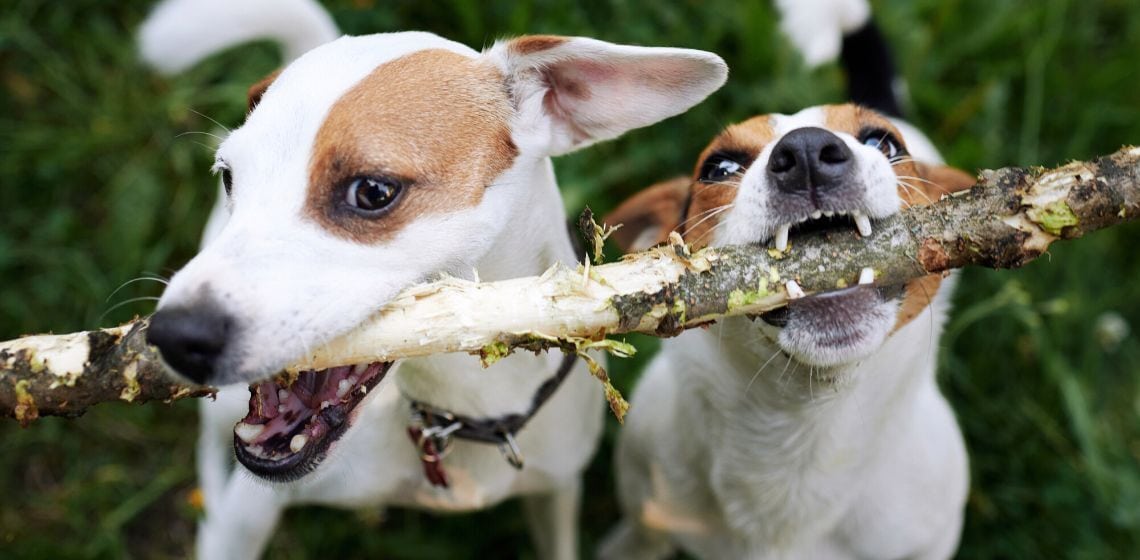Table of Contents
Giardia in Dogs: What Should You Know?
Giardia is a commonly seen parasite in our four-legged friends. Recognizing signs and promptly treating giardia in dogs helps protect your dog and others.
What is Giardia?
Giardia duoedenalis, a simple one-celled organism (protozoan), comes in seven varieties (genotypes)— A through G. Our canine friends usually become infected by the C and D varieties. While humans are generally concerned with A and B, the A and B varieties can infect multiple species, including canines.
What Causes Giardia in Dogs?
Giardia spreads in dogs via the fecal-oral route. In other words, dogs and other species shed the infectious stage (cyst) in their stool. This contaminates the ground, water, food sources, and other parts of a dog’s environment. Because of a dog’s naturally curious nature and exploration of their world with their mouths and noses, they easily ingest the cysts, causing infection.
Once a dog ingests the cyst, it enters the dog’s intestine. There it transforms into a trophozoite stage. This feeding stage then attaches to the wall of the intestine. When sufficient numbers of the parasite are present, this leads to clinical signs, as the parasite causes damage to the intestinal wall.
This can lead to trouble absorbing nutrients. The trophozoites reproduce and develop into the cyst form shed in a dog’s stool. Then an unknowing, non-infected dog investigates that area, ingesting cysts, and the cycle begins anew.
Signs of Giardia in Dogs
Many dogs with giardia never show any symptoms. They remain free of signs but can still shed them in the environment and infect others.
If a dog does show signs, it may have diarrhea on and off. Some may show decreased energy or appetite, but dogs generally show mild symptoms.
Generally, if dogs show signs, we may see
- Diarrhea (soft to liquid stools) – if blood is present, it generally occurs from straining rather than from the organism itself
- Steatorrhea (fatty stool)
- Belly pain
- Weight loss
- Uncommonly, dehydration
- Dull fur coat quality
Giardia symptoms in puppies can vary from no signs to waxing and waning episodes of diarrhea to failure to put on weight or weight loss. Puppies are more likely to develop dehydration if diarrhea is severe. Most of the time, dogs with giardia still want to eat regardless of the pet’s age.
How Do We Diagnose Giardia in Dogs?
We diagnose giardia in dogs when we evaluate their feces. We may find it when doing a routine fecal (stool sample evaluation) at a pet’s annual visit and in the face of vomiting or diarrhea.
- Stool (fecal sample) — Suppose a dog’s stool sample comes back showing the presence of giardia cysts (infectious) or trophozoites (non-infectious stage), and they have clinical signs. In that case, we presume that giardia is the cause. This sample needs to be fresh and recently collected, ideally. Multiple samples over several days may be required to identify the organisms because not every dog sheds cysts consistently.
- Antigen test (ELISA tests) — Check for a marker that is only present if the organism has been or is in the pet at some point. This test should be positive when cysts/trophozoites are also found in the stool. However, this test may also be positive without evidence of the parasite in the feces. This means your pet was exposed and either cleared the infection themselves, never developed enough parasite burden, or isn’t currently shedding the organism.
- PCR panel— Newer testing allows for the detection of a specific genetic part of the organism, when identified, suggests active infection
Giardia isn’t always easy to identify. Therefore, in dogs with clinical signs suggestive of giardia, including vomiting, diarrhea, intermittent stool changes, a combination of fecal flotation (stool sample), antigen, or another type of testing may be needed over several days to truly identify the culprit.
Treating Giardia in Dogs
Treating giardia in dogs is relatively easy, though it may require more than one course of therapy.
Treatment may include:
- Medications
- Probiotics
- Nutritional support — a band diet or prescription bland diet (well-balanced)
- Fluid support in severe cases
Treating giardia in dogs can be simple. There are no FDA-approved specific treatments for giardia in dogs. However, the standard treatment is a course of a commonly used, generally safe anti-parasitic drug, fenbendazole. Most dogs will be prescribed a 5- to 6-day course of the medication.
A recheck stool sample should be evaluated two to no more than four weeks after the last dose. Ideally, at least two samples should return with no cysts or trophozoites seen before a pet is cleared of the infection.
Treatment Failures – When to Retreat
Sometimes we retest a dog’s stool after therapy, and they are still positive. Suppose your dog started with symptoms that have resolved, and the test still shows parasites. In that case, an additional course of treatment is necessary. If your dog isn’t showing any signs but remains positive, your vet may or may not retreat, depending on the pet’s age and other factors.
Some pets seem a bit more resistant to treatment than others. Resistance can occur due to:
- Reinfection from a contaminated environment,
- Re-ingesting their own feces (or grooming cysts off of themselves)
- Drug resistance,
- Immunosuppressed patients.
If additional treatment is needed, a second medication, metronidazole, may be used if symptoms continue and cysts remain in the stool. It may be added in combination with fenbendazole to improve treatment outcomes or used as a sole therapy.
Additional Supportive Care
Ask your veterinarian for a probiotic with veterinary medical evidence to support use and effectiveness. This can assist your dog’s GI tract repair and establish a healthy microbiota (healthy gut flora) and immune system while treating diarrhea and the parasite.
Uncommonly, a pet may need fluid therapy and additional supportive care if they become dehydrated or aren’t eating well.
Finally, placing your pet on a bland diet, ideally, prescription dog food helps provide fully balanced nutrition. It will allow the gut to heal but not have to work too hard and be easy to digest.
Is Giardia Contagious to People?
The short answer is yes and no. Generally speaking, giardia subtypes tend to be species-specific. In humans, giardiasis, a giardia infection, is often linked to travel, recognized as a common cause of ‘traveler’s diarrhea.’ The primary method of transmission in humans occurs by drinking contaminated water or, less likely, contaminated food, though other means are possible.
Dogs, too, can become infected with the subtypes that affect humans, though it is rare. As a result, the probability of your dog infecting you is minimal, but that doesn’t imply it can’t happen. Taking adequate precautions to safeguard oneself is critical.
To know if the type of giardia your dog has is contagious to people, additional (costly) testing would be needed. So, while generally, we would not consider a dog’s giardia to be zoonotic (transmissible to people), we cannot be sure. It would be best if you acted as though it could be to protect yourself and your loved ones.
Proper Hygiene & Key Steps to Protect Others
Even if your dog has a form of giardia that isn’t contagious to people, you do not want to contaminate yourself, your family, or other pets. Wear gloves when picking up your dog’s feces, and wash your hands with soap and water after handling feces, even if you were wearing gloves.
Ideally, keeping your dog only on your property would be best until the infection clears. If you must take your dog off your property, always ensure you pick up any poop immediately. Do not have your dog around other pets until the infection clears. This includes no daycare, grooming, boarding, pet stores, dog parks, or other activities until you have the all-clear from your vet.
So, make sure to promptly remove feces from
- Yards
- Kennels/dog runs
- Crates
- Your dog
- The environment when walking on a leash
Keep your dog clean! Make sure you rinse off/shampoo your dog if any diarrhea/feces remains in the fur. This will lessen the pet’s ability to shed cysts into the environment and prevent reinfection by self-grooming and ingesting the cysts from grooming activities.
Disinfecting the Environment
Giardia is a hardy organism, lasting in the environment in the cyst stage for weeks to months, especially in warm, damp areas. Disinfectants inactivate the cysts, rendering them non-infectious. Cleaning options for soiled surfaces and bedding include:
- Quarternary ammonium compounds
- Bleach (1 part bleach to 16 to 32 parts water)
- Steam
- Boiling water
Always leave cleaning solutions on the infected surface for 5 to 20 minutes (depending on the product) before rinsing/cleaning surfaces. Also, make sure surfaces dry well as the cysts do dry out – surviving better in moist, damp environments.
Giardiasis in Dogs – Overall Good Prognosis
Giardia is a commonly seen parasite in dogs. Some dogs can become infected without developing clinical signs but can shed it into the environment. In contrast, others may develop diarrhea, fatty stools, belly pain, or other symptoms. If your pet is diagnosed with giardia, give medications as directed and take care to protect yourself and others from exposure. Clean up your environment and practice proper hygiene. The prognosis with giardia therapy is good, and most dogs recover without incident.
The standard treatment is 5-6 days. However, some dogs need repeat treatment, either because they keep getting re-exposed or because it can be hard to entirely eliminate the organism in some dogs. Treatment after 2 courses generally isn’t needed as long as symptoms resolve.
Giardia parasites in dogs may cause no abnormalities but can cause soft stool, liquid stool, or any variation in between. There may also be a fatty consistency to the stool, mucous, a greenish tinge, or, less commonly, blood.
Giardia can be treated successfully with one of two medications in most cases. Fenbendazole, our treatment of choice, works for most pets, though sometimes metronidazole is needed. Not all dogs fully clear the infection, so a ‘cure’ isn’t always possible. However, a dog without symptoms and not shedding cysts doesn’t pose a threat to others.

Dr. Tramuta-Drobnis keeps herself busy as a veterinarian and public health professional, a freelancer, writer, and researcher. Receiving her Veterinary Medical Doctor degree (2005) from the University of Pennsylvania and her Master’s in Public Health from the University of Florida, she’s accrued over 17 years of veterinary clinical experience. Her work with small animals and exotics span general practice, emergency, and critical care medicine. She has a passion for One Health, infectious diseases, pain management, veterinary nutrition, and more.








